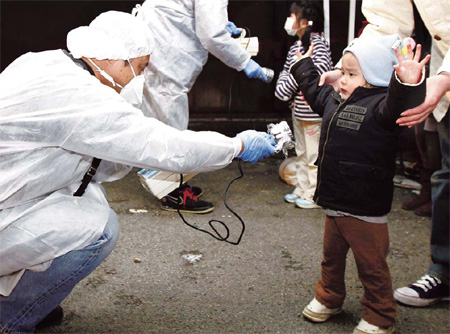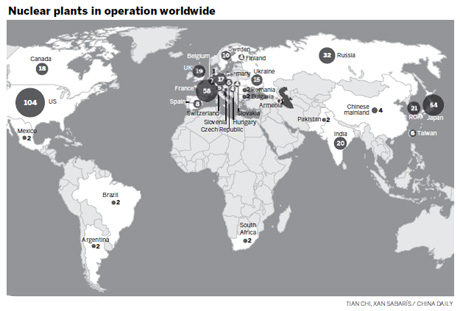'Nuclear meltdown'
Japan fought on Sunday to avert a meltdown at two earthquake-crippled nuclear reactors, describing the massive quake and tsunami, which may have killed more than 10,000 people, as the nation's biggest crisis since World War II.
The country is struggling to respond to a disaster of epic proportions, with millions of people without water or power and whole towns wiped off the map.
The Japanese Meteorological Agency upgraded the magnitude of Friday's massive earthquake from 8.8 to 9.0 on Sunday, the strongest ever recorded in Japan.
"The earthquake, tsunami and the nuclear incident have been the biggest crisis Japan has encountered in the 65 years since the end of World War II," a grim-faced Prime Minister Naoto Kan told a news conference.
 |
|
Medical officials check for signs of radiation on children from the evacuation area near the Fukushima Daiichi nuclear plant in Koriyama, Japan, on Sunday. |
"We're under scrutiny on whether we, the Japanese people, can overcome this crisis."
He said the nation's future will be decided by the choices made by each Japanese person and urged all to join in their determination to rebuild the nation.
As he spoke, officials worked desperately to stop fuel rods in the damaged reactors from overheating, which could in turn melt the container that houses the core, or even explode, releasing radioactive material into the wind.
A complete meltdown - the collapse of a power plant's ability to keep temperatures under control - could release uranium and dangerous contaminants into the environment and pose major, widespread health risks.
Chief Cabinet Secretary Yukio Edano said on Sunday that a hydrogen explosion could occur at No 3 reactor of the Fukushima Daiichi nuclear complex, the latest reactor to face a possible meltdown.
That follows a blast the day before in the power plant's No 1 reactor, and operators attempted to prevent a meltdown there by injecting seawater into it.
"At the risk of raising further public concern, we cannot rule out the possibility of an explosion," Edano said.
He said there might have been a partial meltdown of the fuel rods at the No 1 reactor. Engineers were pumping in seawater, trying to prevent the same happening at the No 3 reactor.
"The use of seawater means they have run out of options," said David Lochbaum, director of the Union of Concerned Scientists Nuclear Safety Project.
The operator of the nuclear reactors said on Sunday the top of fuel rods at the reactors had been three meters above water, an indication of a possible meltdown.
Tokyo Electric Power warned that the No 3 reactor was overheating and that so much of the cooling water had briefly evaporated that mixed oxide fuel rods were exposed to the air, Kyodo news agency said.
"Radiation has been released in the air, but there are no reports that a large amount was released," Jiji news agency reported.
Up to 160 people might have been exposed to radiation, said Ryo Miyake, a spokesman from Japan's nuclear agency. The severity of their exposure, or if it had reached dangerous levels, was not clear.
 0
0 









Go to Forum >>0 Comments